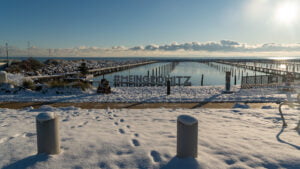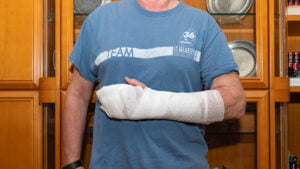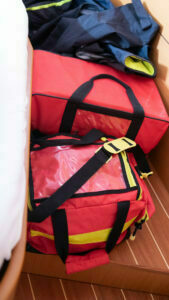ISAF and World Sailing "Safety at Sea" Training / Offshore Personal Survival Course
The sea can, on occasion, be a rough place. When at sea one is away from land and therefore far from the typical emergency services that we have become used to when living in civilization. Being mentally prepared to deal with problems of any type is important and the ISAF “Safety at Sea” curriculum has been designed for offshore racing crews but is applicable to anyone leaving sight of land. The minimum ISAF curriculum covers important topics and the course lasts 2 full days. While there is a lot of classroom learning, the really useful and important bits are practical sessions: in the water and simulated situations on the water.
My first course was taken with a normal commercial / club operator and was very informative. We had some great classroom presentations and some quality time in the pool with simulated waves, capsizing and helicopter rescues. Played around with small fires and talked about handling emergency situations like leaks and breakages aboard. The two days went by quickly and by the time it was over we were exhausted. But my subsequent training courses took this to another dimension.

The German Navy offers an ISAF course twice a year to civilians at their training centre in Neustadt bei Holstein in northern Germany. Participant numbers are limited to around 30 each time and despite costing a bit more, the training is nonpareil. They have a simulated ship’s hull to train leak and damage control. A whole building to practice dealing with fire that includes a dummy burning helicopter. Germany’s biggest wave pool – not in terms of length but in terms of wave shape and height. The pool can create/simulate deadly shoreline breaking waves and huge storm waves with short periods.

I’ve taken this course 3 times now, although I had a training accident during the December 2023 course; I bruised my ribs and cut my hand badly while helping a fellow sailor who’d fallen between the life raft and wave pool wall. He also had to head to the ER for head wound stitches and observation. As Aleksander Suvorov is said to have succinctly stated “Train hard, fight easy”.
Double click on each section title below to expand or collapse the sections:
Dealing with Fire ("Bring out the marshmallows")
Despite being surrounded by virtually unlimited amounts of water to extinguish a fire, it is generally preferable to keep that water on the outside of hull rather than on the inside. Each flag country has different rules about the number and type of fire extinguishers and fire prevention/mitigation equipment. These rules specify minimums and most boats have only that minimum, much of the time that equipment is outdated as well. While the fire training portion of the classes was perhaps the most fun, it isn’t as applicable to the small sailboats we find ourselves upon. This class was for dealing with big fires and several of the exercises used large multi-person hoses for big fires. But the training was very helpful in dealing with smaller fires as well. The techniques remain the same, just using different materials.
One of the exercises was a simulated small boat fire (a kerosene fire in a metal bucket) and we were given a small extinguisher of the type most of us have aboard.
This small extinguisher only put out that fire if used just right, most of the time the extinguisher was empty and the fire continued roaring merrily away. I’ve since added larger extinguishers aboard my boat.
Dealing with Water ("Is that floorboard supposed to be floating?")
What to do when the water doesn’t stay outside but comes inside uninvited? This part of the ISAF training takes place inside a virtual metal hull. We get to put on overalls and galoshes and go “inside” in small teams. There are a couple of mallets, cushions and various pieces of wood. The instructions are simple – stop the leaks or slow them down. If the water reaches a certain height you can turn on the big pumps to assist. If the water continues rising then you’ve failed and drowned.
One of the walls is cut away so that the other teams can watch the action and hopefully learn from. The first time I did this I was in the first group and didn’t know what to expect and after surviving a couple of bigger leaks I thought that the second group had it easy since they’d seen the leaks and listened to our debriefing about how we could have done better. But when that group came in they got a whole different set of leaks – as did all the other teams.
Sailboats are smaller and tend to have fiberglass rather than steel hulls, and there’s usually less crew available. But some important lessons remain.
The first is that water doesn’t come in under pressure, no big spray like the Hollywood scenes in the “Poseidon Adventure”. It takes just a bit of pressure on the inside to stop water ingress, see one of the pictures below where one of the crew put a cushion on the leak and just sat on it (because of the location, we couldn’t get any bracing put in place).
The second is improvisation and creativity. Even with limited tools it is possible to get creative and plug even big holes.
And when bracing use right angles and always use wedges in pairs.
And taste the water. If you are at sea and the water coming up is not salty, then you’ve got a water tank leak and since the water was already inside the boat there’s no danger of immediate sinking.
Luckily the water used for this exercise was warmed up and was fresh water rather than sea water.
Dealing with Separation ("I don't want to leave")
While there comes a time in a relationship where one needs to go separate ways, splitting up with your vessel at sea is not best choice. But sometimes you need to go apart, particularly when your boat decides to become a submarine or go up in flames.
This part of the ISAF training is perhaps the most applicable and where the military version is miles ahead of the commercial ones. They use a custom-built wave pool that generates some serious waves in whatever height and shape is needed. When I did the ISAF course in Düsseldorf, we were put into a liferaft and they had some swimmers outside shake the raft around. Here in Neustadt we got crammed inside and those waves shook us around for a good 10-15 minutes and many were close to turning green and I swear I got some air-time!
After we’d been through the wash cycle and appropriately prepared, we had to simulate climbing up the side of a hull while the waves pounded us. Once up top we then had to jump back in the water, inflate our vests and do some team-survival exercises in the waves. And then, suitably tired, we had to try to get into the liferafts again. That is much more difficult than it sounds.
One time they heard I was a single-hander and made me try to get into one of the rafts alone. Wow – I almost couldn’t get in and only made it inside with the last of my strength.
Then we all put on our own offshore gear, including boots, and our own lifevests and got to see how waterlogged and heavy we became.
Some were chosen for simulated helicopter rescue, and we got to try lifting fully clothed “survivors” out of the pool.
And one exercise showed me how important those spray-hoods are. The waves were set to shoreline break mode and participants were towed into the surf zone. Without a spray-hood they stood little chance of survival.
Dealing with Attention("Hey there, can you hear or see to me?")
This part is for the extroverts who want everyone to see and hear them! But it’s also for the pyromaniacs as we get to set off smoke bombs, hand-held flares and get to shoot flare rockets as well.
Those hand-held flares are designed to keep burning until all the compound has been oxidized and they burn very hot. They might, if dropped, torch their way through a hull or ignite things – meaning we’d have to revisit things learned in lesson 1 above!
Dealing with Health ("But Doc, what do you mean it'll take 5 days to get here?")
 This section of our training is purely theoretical. It is held my a marine doctor and discusses typical injuries aboard (burns, trauma, and sea-sickness) and how to deal with them in the short term and keep the patient alive in the long term.
This section of our training is purely theoretical. It is held my a marine doctor and discusses typical injuries aboard (burns, trauma, and sea-sickness) and how to deal with them in the short term and keep the patient alive in the long term.
Ashore in the first world the first-aid courses are geared to stabilizing the patient for 10-15 minutes until the professionals arrive. At sea one needs to take different action as help is going to be hours away at best and weeks away at worst.
Likewise the medicines (analgesics, antibiotics, salves) and tools (splints, bandages, monitoring equipment) are different from a standard home first-aid kit.
But I’ve attended advanced offshore medical courses and will go into more detail in that post.
Dealing with Theory ("Back at the desk in the classrom")
What we couldn’t do for real in training had to be done in theory in class. Being a military base, we had real order in the classroom. Long benches with chairs upended on top, which we had to replace when leaving. The walls covered with schematics of corvettes and destroyers. And ABC warning posters and procedures.
Some of those reading these pages won’t ever have seen overhead projectors that aren’t digital before, but those were still in use here.
As expected in Germany, we spent a good amount of time talking about legalities and correct procedures in all sorts of situations.
